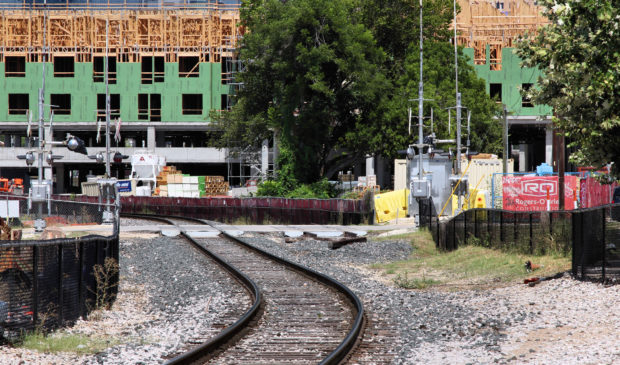Council to adopt Project Connect TOD plans by next summer, early code fixes by year’s end
Monday, June 14, 2021 by
Jonathan Lee City Council on Thursday laid out its land use planning priorities for areas near Project Connect stations, passing a resolution directing city staff to help with the Capital Metropolitan Transportation Authority’s Equitable Transit-Oriented Development (eTOD) studies.
The studies will lead to station-area plans for Project Connect’s Orange and Blue light rail lines, Gold Line bus rapid transit line, Red and Green commuter rail lines, and MetroRapid bus routes. The plans are meant to boost transit ridership by allowing denser development near stations while also preventing displacement of existing residents and creating affordable housing.
Within six months, city staff will recommend preliminary policies for Council to adopt based on their work with Capital Metro. Within 14 months, staffers will publish a comprehensive “eTOD Policy Plan,” which Council could adopt in its entirety or alter before adopting. Council hopes that including city staff in Capital Metro’s eTOD planning will lead to seamless administration of the new land use regulations.
Regulations could include zoning that allows taller and denser buildings with relaxed site development constraints like impervious cover, setback, and floor area ratio requirements. Other land use tools could include density bonus programs and decreased parking requirements, including parking maximums. The resolution makes clear that each TOD area will be different, and that neighbors will help shape the planning.
“Allowing the highest possible ridership is how we’re going to get the most out of our investment,” said Mayor Pro Tem Natasha Harper-Madison, who sponsored the resolution. A UCLA study, mentioned in the resolution, determined that for investment in light rail to be worthwhile, areas near stations need at least 56 residents and jobs per acre. Harper-Madison noted that such density “will also make it more likely that we get as much federal funding as possible.”
The eTOD Policy Plan will also inform how Project Connect’s $300 million in anti-displacement funding is spent. The resolution mentioned many potential anti-displacement policies, including land-banking, acquisition of existing affordable housing, tax increment financing, right to stay and right to return policies, and acquiring properties, including those partially in the light rail right of way, for affordable housing.
Much of the debate on the resolution occurred between Harper-Madison and Council Member Ann Kitchen through back-and-forth amendments tweaking the resolution’s language.
Kitchen wished to include language that broadens the role of neighborhood groups and other stakeholders in the crafting of the plans. Harper-Madison argued that while community engagement is key, it should be done in an equitable way, involving people who usually do not participate in neighborhood land use debates.
“While the desire to telescope the planning process down to the neighborhood-level is appreciated, the intent of this resolution is to have equitable processes that produce equitable outcomes. Neighborhood power structures are largely dominated by single family homeowners who are generally older and wealthier than the median resident of our majority-renter city,” Harper-Madison wrote to justify altering one of Kitchen’s amendments. “Without all voices at the table, we end up with systems that reinforce economic segregation and perpetuate the feedback loop of institutionalized poverty.”
Harper-Madison and Kitchen also disagreed over whether the eTOD studies should include non-MetroRapid bus routes. Kitchen argued that because regular bus routes can change – Capital Metro reorganized its bus routes as recently as 2018 – they should not be part of the studies. She also urged that the planning focus on the highest-capacity routes. Harper-Madison called the inclusion of bus lines a key equity concern. “It would be my hope that this Council would be supportive of development patterns to equitably serve our low-income residents and communities of color who disproportionately rely on the bus,” Harper-Madison said.
In the final version of the resolution, non-MetroRapid bus routes were not included as potential eTOD areas. However, the resolution does direct city staff to explore transit-oriented land use policies in certain areas without designating them as eTODs.
Photo by Larry D. Moore, CC BY-SA 4.0, via Wikimedia Commons.
The Austin Monitor’s work is made possible by donations from the community. Though our reporting covers donors from time to time, we are careful to keep business and editorial efforts separate while maintaining transparency. A complete list of donors is available here, and our code of ethics is explained here.
You're a community leader
And we’re honored you look to us for serious, in-depth news. You know a strong community needs local and dedicated watchdog reporting. We’re here for you and that won’t change. Now will you take the powerful next step and support our nonprofit news organization?




